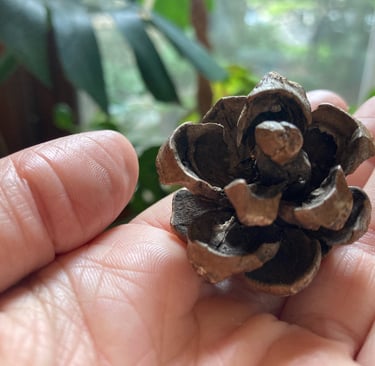Tree story #1: Jack pine
Lucy Rea
6/10/20252 min read


This story begins not with a tree (though they will play a role), but with a little yellow songbird. The Kirtland Warbler makes its summer home in a very specific part of Michigan’s north woods. In 1967, the number of Kirtland Warblers had declined so far that it was listed as an endangered species, and conservationists worked on a plan to help the Kirtland Warbler’s population recover. It turns out that this little bird is a bit picky about where it nests.
Here's where our tree comes in. The Kirtland Warbler nests only in a very specific species of tree: the Jack pine. This tree’s scaly bark, twisting needle leaves, and occasionally crooked trunk gives it a scruffy appearance. Its preference for sandy soils in the boreal regions of North America adds to its rugged aura.
And not only do the Kirtland Warblers need to nest in Jack pine – they require young Jack pine to nest. Now, for hundreds of years this level of picky-ness had not been a problem for the Kirtland Warblers. But post-colonization, the number of young Jack pines began to decrease.
See – where Kirtland Warblers are a bit like Goldilocks (they need conditions to be just right), the Jack pines also have very specific needs to grow their young. The Jack pines needs are just a bit…hotter. Jack pine cones (which contain the seeds that will grow into new young Jack pine trees) are sealed with a resin that needs to be heated by fire to open and release the seeds.
Fire suppression from colonization and western approaches to land management disrupted the normal, natural cycles of fire that this ecosystem historically experienced and adapted to. Less fire meant Jack pine cones couldn’t get hot enough to open and release their seeds – which means fewer young Jack pines. Over the years, as the make-up of Jack pine populations became older, new generations of Kirtland Warblers found themselves with fewer options to make their home (my Millennial and Gen Z friends dealing with the current housing market may relate to this).
Given the layered dependencies of the Jack pine and thus the Kirtland Warbler on fire, land managers began implementing prescribed burns of Jack pine forests as one of many tactics to increase Kirtland Warbler numbers. This may seem counter intuitive to set the Kirtland Warbler’s habitat on fire, without knowing that the Jack pines depend on fire to increase their numbers.
However, setting the forest on fire (via controlled burns) cleared the way for young Jack pines to grow. And with the growth of young Jack pines (along with other management actions such as removing the eggs of the parasitic Cowbirds) came the growth of Kirtland Warbler numbers.
Now, I’m not here to deliver platitudes and cliches. But I will just say that if we can take anything from the Jack pines and the Kirtland Warblers, we can see the importance of cultivating the young, and be reassured even if it seems like the world is burning down around us, it may be paving the way for something beautiful that has been waiting to emerge.
Additional reading:
